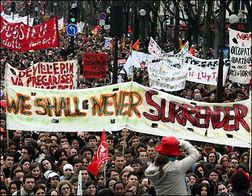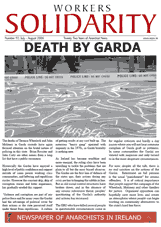Over 30 years of anarchist writing from Ireland listed under hundreds of topics
CPE Victory for French youth
 During March and early April a wave of protests and occupations gripped France. On March the 7th over one million people protested against the French government’s attempt to introduce the C.P.E., a new law that reduced the rights of young workers.
During March and early April a wave of protests and occupations gripped France. On March the 7th over one million people protested against the French government’s attempt to introduce the C.P.E., a new law that reduced the rights of young workers.
The five weeks that followed saw 68 Universities occupied as students and workers went on strike. The government responded to this popular protest by unleashing the notorious police force, the C.R.S against the strikers. Thousands of arrests were made and a 39 year old Trade Unionist was put in a coma following a brutal attack by the police.
The current wave of unrest is the latest in a series of social upheavals in France. The protests against pension cuts in 2003, the protracted strikes in Marseilles and the rioting of the urban poor in late 2005 show the failure of capitalism to guarantee a decent standard of living for people.
The unemployment rate among young people in France is 25% and is as high as 40% for the unskilled. The C.P.E. was supposedly an attempt to solve the unemployment crises but as always it was the workers that were expected to suffer for the wellbeing of the economy.
In 2005 the C.N.E. was passed which exempted small workplaces from the majority of labour laws and protection for employees. The C.P.E. was next step in the process of reducing the rights of workers and weakening the trade union movement.
The new law allowed employers to fire young workers at any stage during their first two years of employment. It reintroduced night work for people as young as 15 and lowered the school leaving age to 14. The new law encouraged bosses to hire young, easily exploitable workers, and then fire them before they became permanent or had the audacity to fall sick or join a union.
The effect would have been to create a pool of insecure, low paid workers that could have been used to drive down wages throughout the French economy. It introduced job insecurity as a method of controlling workers and the union movement. Workers and students throughout France recognised this and decided to stand up against this latest attack on their living standards.
Universities were occupied and democratic decision making bodies were set up among the students. General assemblies were held and delegates were elected to allow the assemblies to organise on a national basis. The actions of the students became a catalyst and focal point for popular discontent.
School students went on strike, impoverished youth from the poorer housing estates (banileus) joined their peers, and workers linked their struggles to those of the students. The popular grassroots support that the students received forced the moderate unions into action. Four days of protest were called, culminating on March 28th when over three million people took to the streets to demonstrate across the country.
The popularity of the student revolt, the possibility of it spreading and their willingness to engage in direct action forced the government to back down. Despite blustering promises to the contrary on Monday 10th of April, just over a week after signing the C.P.E. into law, the French government was forced into a humiliating climb down and promised to scrap the law.
The French government’s plans were just the latest in a series of attempts by bosses and governments across Europe to drive down wages and working conditions. In Ireland we have already seen widespread exploitation of young and foreign workers, the efforts to undercut unionised jobs and now the privatisation of Aer Lingus. It is only by linking the struggles of young people and workers that we can effectively fight back against the agenda of the bosses and their lackeys in government.
John Flood
|
This article is from You can download the PDF file of WS92 |
 |

